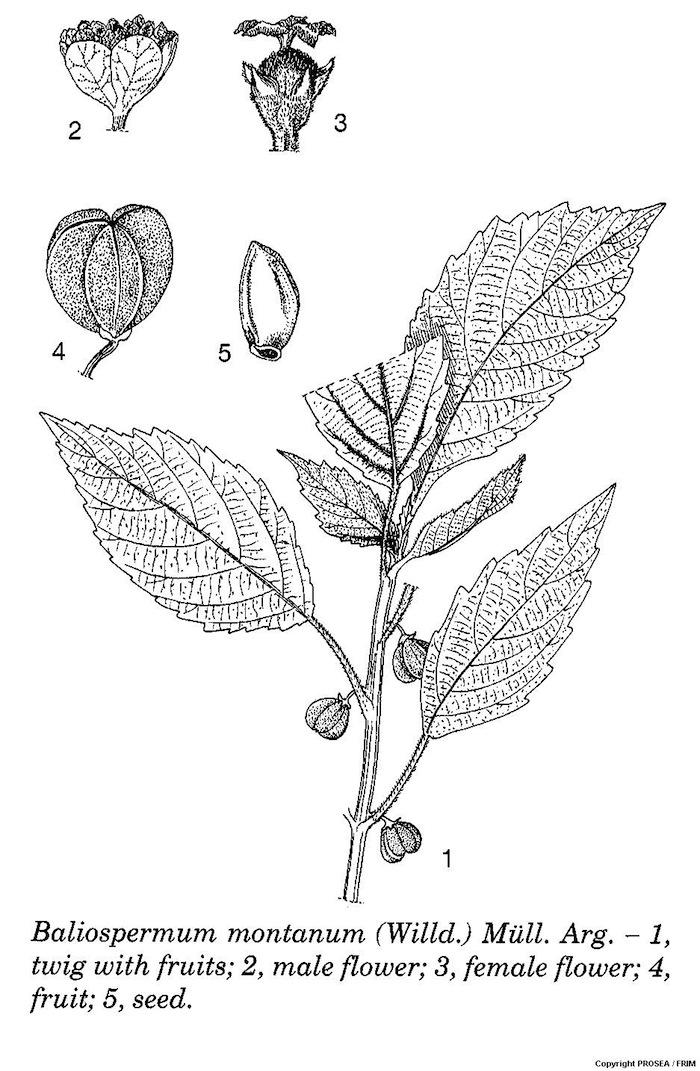Scientific Name
Baliospermum solanifolium (Burm.) Suresh
Synonyms
Baliospermum angulare Decne. ex Baill., Baliospermum axillare Blume, Baliospermum indicum Decne., Baliospermum montanum (Willd.) Müll.Arg., Baliospermum moritzianum Baill., Baliospermum pendulinum Pax, Baliospermum polyandrum Wight [Illegitimate], Baliospermum raziana Keshaw, Murthy & Yogan., Croton polyandrus Roxb. [Illegitimate], Croton roxburghii Wall., Croton solanifolius Burm., Jatropha montana Willd,. Ricinus montanus (Willd.) Wall. [1]
Vernacular Name
| Malaysia | Akar kara nasi, terap kompong, maharaja lela (Peninsular) [2][3] |
| English | Castor oil plant [3] |
| China | Da nti (Tibet) [3] |
| India | Anukheti, anukula, appaiccevakaceti, appaiccevakam, artagala, bambhatti, bedanjire khatai, bhadra, buktumbo, cimai amanakku, cimaiyamannakku, dantan, dante, danthi, danti lambi waali,danti mool, dantika, danimool, donti, dravanti, dumajoda, dumbojoda, erandapatri, erandaphalaa, erradundinga, ettadundiga, gunapriya, habbussalatine-barri, habbusalatine-sabrai, hakni, hakum, hakuna, harital, illantanamanaklu, irancani, jamal ghota, jamalghota, jangli, jamaalgotaa, kaadu haralu, kaduharalu, kakubha, kanaka pata, kanakapaata, kanakapata, kanniyuchari, katalavanakku, kattamanakku, kattamankku, kondamudamu, kumbhachitra, kumbhi, kumpam, kurantaka, madhupushpa, makulaka,makunaka, maniyamanakku, maniyamanakkuceti, mukulaka, naaga danti, naga danti, nagadandi, nagadhanti beru, nagadanthi, nagadanti beru, nagadhanthi, nagas phota, nagavinna, nagdanthi, nakadanti, neelajiddi, neeradimuthu, nela jiddi, nelajidi, nepala, nepalam, nervalam, nikumba, nikumbha, nikhumbah, nikhimbi, nir adimutthu, niradimuthhu, niratimuthu, nirettimuttu, nirveti, nishalya, nishkumbha, parankiyamanakku, pey amanakku, peyamanakku, phan tap, pratyak-sherni, rakdhanti, rechani, rikhsa, sapdi, shighra, shighraa, shimaiamannaku, shwetaghanta, shyenaghanta, sighra, tanti, taruni, timpalai, turuvati, udumbarparni, upachitra, upakulya, varahangi, vishaalya, vishalya, vishodhini [3] |
| Indonesia | Kasingsat (Sundanese); srintil, adal-adal (Javanese) [2] |
| Thailand | Tong taek (Central); thon di (Central, Trang); nong pom (Loei) [2]; long pom, nong pom, pho-bho-cho, tho-klo, thon-di, tong taek [3] |
| Myanmar | Natcho [2] |
| Vietnam | C[aar]m t[uwr] n[us]i, c[oj] t[uw]a [2] |
| Bangladesh | Tungkramon [3] |
| Nepal | Ajaphal ka bot [3] |
Geographical Distributions
Baliospermum solanifoliumoccurs in Pakistan, India, Bhutan, Bangladesh, the Andaman Islands, Burma (Myanmar), Indo-China, southern China, Thailand, Peninsular Malaysia, Sumatra, Java and Sumbawa. [2] In Java, B. montanum occurs in open forests such as teak forests, brushwoods and grasslands, up to 250 m altitude. In Peninsular Malaysia, it is found in lowland forests but uncommon. It has been found only once in northern Sumatra. It is more common in India, Burma (Myanmar) and Thailand, where it occurs in moist or dry evergreen forests, bamboo forests and scrub vegetation up to 700 m altitude (in India and Burma (Myanmar) up to 1300 m). [2]
Botanical Description
B. solanifolium is a member of the family Euphorbiaceae [1]. It is a monoecious or sometimes dioecious bushy shrub, which can grow up to 2 m tall and often of somewhat herbaceous texture. The young branchlets are angled and striate, with yellow hairs but becoming hairless and often reddish with age [2].
The leaves are arranged alternately, simple, elliptical to oblong, broadly ovate, obovate or ovate-lance-shaped, measuring 5-25(-38) cm x 2.5-13(-18) cm, sometimes 3-5-lobed, slightly cordate to wedge-shaped at base, acuminate at apex, coarsely dentate at margins, pinnately veined and sometimes prominently 3-veined from base. The petiole is 1-11(-17) cm long, with 2 glands at apex. The stipules are gland-like. [2]
The inflorescence is an axillary with cyme up to 4 cm long. It is unisexual or bisexual and arranged on leafy branches. The bracts are up to 1.5 mm long. The flowers are unisexual, pedicelled, with 5 imbricate, pale green to reddish perianth lobes (petals absent) and lobed-crenate disk. The male flowers are about 2.5 mm in diametre, with 14-25 free stamens while the female flowers are with superior, nearly globular, 3-lobed and 3-celled ovary, 3 styles, connate at base and prominent bifid stigmas. [2]
The fruit is nearly globular, with 3-lobed capsule, which is up to 13 mm in diametre and 3-seeded. [2]
The seeds are ovoid, up to 9 mm long, grey, marbled, shiny, carunculate and with fleshy endosperm. [2]
Cultivation
No documentation
Chemical Constituent
No documentation
Plant Part Used
No documentation
Traditional Use
No documentation
Preclinical Data
No documentation
Clinical Data
No documentation
Poisonous Management
No documentation
Line Drawing

References
- The Plant List. Ver1.1. Baliospermum solanifolium (Burm.) Suresh [homepage on the Internet]. c2013 [updated 2012 Mar 23; cited 2015 Apr 15]. Available from: http://www.theplantlist.org/tpl1.1/record/kew-19558
- Lemmens RHMJ, Bunyapraphatsara N, editors. Plant Resources of South-East Asia 12 (3): Medicinal and Poisonous Plants 3. Leiden, Netherlands: Backhuys Publication; 2003.
- Umberto Q. CRC World Dictionary of Medicinal and Poisonous Plants: Common Names, Scientific Names, Eponyms, Synonyms, and Etymology (5 Volume Set). Boca Raton, FL: CRC Press; 2012. p. 26.


